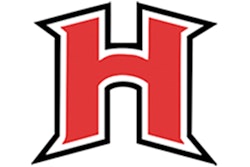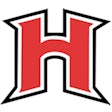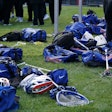![[Photo courtesy of University of Nebraska Athletic Department]](https://img.athleticbusiness.com/files/base/abmedia/all/image/2020/04/ab.nuti420_feat.png?auto=format%2Ccompress&q=70&w=400)
Kayla Martin used to fuel up for Penn State University track and cross-country meets by consuming packets of honey she gathered from local restaurants. She'd counter her tendency to cramp with what she calls "savory oats" — that is, oatmeal laced with similarly procured salt packets. She supplied her own Gatorade, as well.
Martin competed for the Nittany Lions not that long ago — from 2001 to 2005 — but so much has changed within the universe of student-athlete nutrition that her personal fueling strategies might seem light years away. "I didn't know what I was doing," says Martin, a runner who was actually on the right track, thanks in part to a nutrition class she was taking at the time.
The fueling and refueling of collegiate student-athletes everywhere has taken tremendous strides since 2014, when the NCAA lifted restrictions on how schools can go about feeding their sports rosters. That legislation led to an explosion in hiring of registered dietitians by athletic departments determined to meet the demands of their hungry constituents. It also led many schools to renovate spaces inside existing athletic facilities to accommodate new fueling stations located along student-athletes' daily traffic patterns —just outside a weight room, for example, or within a player lounge — but often immediately adjacent to where their heaviest exertion takes place. Still other schools have had the good fortune to design full dining facilities or satellite snack stations from scratch, allowing architects and nutritionists to collaborate on state-of-the-art spaces unimaginable only a decade ago.
![[Photo of Penn State University courtesy of Advent]](https://img.athleticbusiness.com/files/base/abmedia/all/image/2020/04/ab.nutri1.png?auto=format%2Ccompress&fit=max&q=70&w=400) [Photo of Penn State University courtesy of Advent]
[Photo of Penn State University courtesy of Advent]
Today, Martin is Penn State's assistant athletic director for performance nutrition services, one of only a handful of registered dietitians among the hundreds now working on college campuses across the country to have AD as part of her title. Penn State was early to the new fueling party, too, opening the Lasch Football Nutrition Bar in 2015.
"Food is our agent of change, so to be able to provide fuel to these athletes and teach them by example is very impactful and powerful," says Martin, who became the nation's 18th sports dietitian in 2010, during a stint at Notre Dame. "It's been a really awesome transition from my time as a sports dietitian before all these rules happened in 2014 — where we weren't able to provide as much and we were on our own — to now being able to better serve the athlete, to help them to be more durable and to really accelerate in their sports performance."
No two schools are exactly alike in their approach to feeding, but those looking to maximize their delivery of nutrition should consider the following:
![[Photo of Penn State University courtesy of Advent]](https://img.athleticbusiness.com/files/base/abmedia/all/image/2020/04/ab.nutri2.png?auto=format%2Ccompress&fit=max&q=70&w=400) [Photo of Penn State University courtesy of Advent]
[Photo of Penn State University courtesy of Advent]
Receiving
Collegiate student-athletes burn and consume an enormous number of calories daily, which means most food items in a nutrition operation must be delivered to fueling stations on a weekly — if not daily — basis.
Not only is locally produced food a plus in terms of nutritional value, but any fresh food should travel as little as possible once it's on site. This means positioning loading docks as close to preparation and delivery areas as possible.
"What a disaster it is when you find that your kitchen is 50, 70, 80 yards away or even a couple floors away from the dock," says Dave Ellis, who heads a nutrition staff approaching 100, including four full-time registered dietitians, for the University of Nebraska athletic department. "You're talking about time sitting on the dock, which impacts food safety and quality, and a lot of personnel hours over the course of a year to move it from point A to point B. And along the way, it's beating the hell out of everything you go by. Palettes bang on doors and walls as you're moving them through hallways that weren't designed for that."
Proximity is important in both directions. "A good operation starts at the back door," Ellis says. "A smart kitchen has a place to take in deliveries daily right at the back door and a separate area to pump out all of the waste products that come out of a kitchen, whether they be recycled or headed to the landfill or headed to composting. Trash bags full of refuse leak, so the last thing you want to do is drag your food from the dock through your facility and the refuse from food production back through the same facility to get it out of there."
Ellis, who has done much consulting and will help inform architecture firm Populous as it designs Nebraska's forthcoming $155 million, 350,000-square-foot athletic complex, says he even came upon one kitchen in a hot climate that refrigerated its garbage so as not to attract vermin. "There's some pretty cool stuff out there."
![[Photo courtesy of Louisiana State University]](https://img.athleticbusiness.com/files/base/abmedia/all/image/2020/04/ab.nutri3.png?auto=format%2Ccompress&fit=max&q=70&w=400) [Photo courtesy of Louisiana State University]
[Photo courtesy of Louisiana State University]
Storage
As with any other area of an athletic facility, fueling stations require storage — lots of it. Even a 400-square-foot fueling station requires exponentially more storage supporting it.
"When you walk in, all you see is a lovely counter top. You have blenders, you have ready-to-drink smoothies in bottles, but for every fueling station we have there's probably a storage room that's five or six times the size that stores all of our extras," says Zach Bennett, director of football nutrition at Louisiana State University. "Back in the day, when all we had was a cart that had fruit, nuts and bagels on there, we could set it up in the hallway and that was it. Now we have these lavish stations, it's becoming a full food service operation, and so we're having to plan for storage."
Available storage space will influence ordering decisions. "For every box of bars that you have out on the shelf taking up a cubic foot, you have a case with 60 more boxes of those on a shelf in your back storage," Bennett says. "If something's really popular, you have to have hundreds of them on hand. You just can't run out in the middle of the day. The more storage you give yourself, the less ordering you have to do."
Ordering based on type of available storage also comes into play, according to Bennett. "The other thing that's tricky is we have to think about what we order that's refrigerated versus what's shelf-stable, so we have to make decisions on what type of milk we order," he says. "If we order small single servings of milk, generally we try to do those shelf-stable, so they have a longer expiration date and we can store them on a rack. If we did milk cartons like you had in school, those take up a lot more space, and you have to have them in a refrigerator. They expire quickly. So you have to make those judgment calls based on what kind of storage you have, and really you have to designate your storage based on what's popular in your fueling station."
![Nebraska’s already enviable feeding infrastucture will welcome a $155 million athletic complex in 2022. [Photo courtesy of University of Nebraska Athletic Department]](https://img.athleticbusiness.com/files/base/abmedia/all/image/2020/04/ab.nutri4.png?auto=format%2Ccompress&fit=max&q=70&w=400) Nebraska’s already enviable feeding infrastucture will welcome a $155 million athletic complex in 2022. [Photo courtesy of University of Nebraska Athletic Department]
Nebraska’s already enviable feeding infrastucture will welcome a $155 million athletic complex in 2022. [Photo courtesy of University of Nebraska Athletic Department]
Infrastructure and amenities
A space will need adequate plumbing and power to manage the equipment within it. Many fueling stations will feature a three-sink setup, perhaps with rotating brushes and an overhead spray nozzle, for sanitary washing of smoothie-blending components and other dishware, as well as a garbage disposal. Some operations will have onsite domestic-grade dishwashers, while others may opt to cart dishes to a nearby kitchen for industrial washing in a fraction of the time. Another product appearing in training table kitchens is the ORCA Digester, which uses microorganisms to eliminate food waste and divert it from landfills.
A station may feature more than one type of refrigerator — from glass-fronted coolers containing premade energy drinks or grab-and-go snacks to commercial-grade stainless steel fridges and on down to mini-fridges. Freezing capabilities are a plus for the storage of various fruit options for smoothie blending. The blenders themselves may be integrated, allowing the jar portion to be set into motor mechanisms at counter level for an uncluttered look and easier cleanup.
A fueling station may even include the type of roll-down locking door to secure certain parts of the area during unstaffed hours while still offering access to some snack options. TV monitors may be specified to provide daily menu suggestions and other refueling tips.
On a larger scale, training table kitchens can resemble a restaurant's back-of-house in terms of preparation and cooktop square footage, as well as cubic footage in terms of refrigeration. Some schools have even dedicated space to teaching kitchens, where student-athletes can learn to prepare nutritious food for themselves.
"In addition to all the demands in terms of engaging these athletes, these culturally diverse rosters, over three to five years, multiple meals per day and multiple days per week, we have a volume issue. We have a lot of people going through there," says Nebraska's Ellis, who oversees the service of 1,600 to 1,800 meals per day, more than any restaurant in Lincoln. "If you don't have enough of a kitchen to pull off fresh production, you cook it all at 10 o'clock in the morning and stick it in a hotbox. By the last hour or two, you can bounce the meal off the floor. The athletes will fatigue of that, and they don't deserve that."
![Louisiana State’s current dining facilities (right) are considered state of the art. [Photo courtesy of Louisiana State University]](https://img.athleticbusiness.com/files/base/abmedia/all/image/2020/04/ab.nutri5.png?auto=format%2Ccompress&fit=max&q=70&w=400) Louisiana State’s current dining facilities (right) are considered state of the art. [Photo courtesy of Louisiana State University]
Louisiana State’s current dining facilities (right) are considered state of the art. [Photo courtesy of Louisiana State University]
Delivery
Most serveries in training table areas resemble the standard chow line, with hot and cold wells filled with various selections, but special touches can make the experience all the more palatable.
At LSU, which opened its state-of-the-art Football Operations and Performance Nutrition Center last summer, executive chef Mike Johnson presents food in ways more akin to a resort setting. "Just the other day for lunch we had a charcuterie board laid out on one of the islands in the dining hall," Bennett says. "Kids could walk up and there was an array of different types of cheeses and cured meats and jams and jellies and fig preserves and candied nuts. You feel like you're at a hotel and there's an event going on. I've had two or three different people walk up to me and be like, 'Am I underdressed for this? Feels like a restaurant.' "
It's a testament to how far student-athlete feeding has come over the past half-dozen years.
"I've been at many different schools," says Bennett, who's made professional stops at such powerhouses as Texas, Michigan and Georgia, "and this is hands down the best dining hall that I've seen. Our nutritionists and administrators really did their due diligence. They did a lot of research. They traveled to a lot of schools throughout the country, and they asked the right questions. So when they designed this place, there was a lot of thought put into it — and it shows. When you walk in, everything flows. Everything is right where you would think it would be. It's a very intuitive place. It welcomes you in and you feel at home. It's awesome that way."
Are such culinary bragging rights the new campus arms race? There's no question that nutritional infrastructure has taken its rightful place on recruiting tours — as good an indication as any that young prospects will be properly cared for on the campus in question. Beyond that, not much rivalry exists among nutritionists themselves, says University of Wisconsin director of sports nutrition Nick Aures.
"With some schools, there's a little bit of gamesmanship," Aures admits, adding, "In the Big Ten, we all talk. When we travel to other schools, we all make sure to try to meet. We're trying to learn everybody's operation. Each location is so different, so you're really trying to understand different layouts, different ideas, and enhance anywhere you can."
On a far-reaching athletics campus dotted with 17 often sport-specific fueling stations, Aures is always looking to enhance.
"The way I've always viewed it is we're in a healthcare profession. We're there for the students' welfare," he says. "I'm okay with another school knowing what we know because at the end of the day I want to give athletes the best nutrition, but whatever the sport is — wrestling, running — I want that skill to be what decides who wins and who loses."
This article originally appeared in the April 2020 issue of Athletic Business with the title "Designing spaces to deliver optimum athlete fueling." Athletic Business is a free magazine for professionals in the athletic, fitness and recreation industry. Click here to subscribe.





































